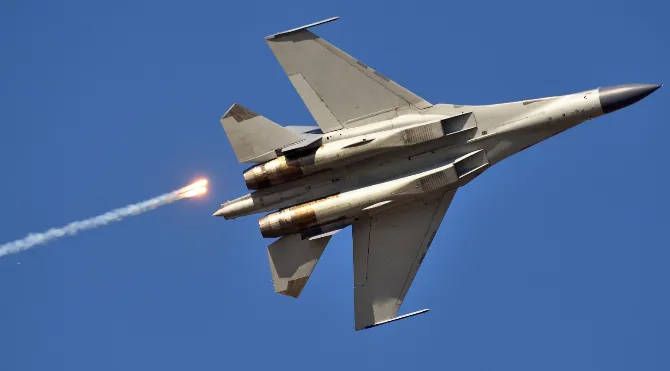
India’s airpower is facing a critical issue—the diminishing strength of its fighter squadrons and the vulnerability of its helicopter fleet. While the Indian Air Force’s (IAF) squadron strength has dwindled to 32, far below the prescribed number of 42, the helicopter fleet has recently been besieged by technical problems, crashes, and emergency landings.
The scenario has been further compounded by many legacy fighter squadrons, including the MiG-21s being phased out by 2025 and the Jaguar and Mirage 2000s planned to be phased out by the decade's end. For the chopper fleet, the Advanced Light Helicopter Dhruv has endured metallurgical and design issues, while the over-3 decade old Cheetah and Chetak fleets are near the end of their service cycle.
Given the dynamic security landscape prevalent in the South Asia region, and India’s fraught northern and western borders, policymakers must double down to resolve this conundrum.
India’s airpower is facing a critical issue—the diminishing strength of its fighter squadrons and the vulnerability of its helicopter fleet.
The fighter squadron dilemma
India’s fighter squadron dilemma has been evolving over the past decade and a half. Its roots can be traced to the Medium Multi-Role Combat Aircraft (MRCA) deal, whose Request for Proposal was launched in 2007 by the Ministry of Defence. After years of trials, negotiations, and deliberations, the MRCA was rebranded as the Multi-Role Fighter Aircraft (MRFA) programme in 2018. Essentially, via both proposals, the plan was to augment the fighter squadron strength of the IAF and provide for the shortfalls that would arise once the legacy fleets were phased out.
However, despite a slew of reports over the years highlighting different deals for different foreign-manufactured fighter aircraft as imminent, India has still not procured any fighters via this route. It can be argued an ambivalent approach by the government has plagued the MRFA/MRCA. This has created the underlying conditions for the current shortfall in India’s fighter aircraft fleet.
While the MRFA remains stalled, the government has tried to augment fleet capacity by placing immense faith in the indigenous Light Combat Aircraft Tejas, manufactured by Hindustan Aeronautics Limited. In 2021, the government ordered 83 Tejas MK1A jets, scheduled for delivery from February 2024. Further, on 30 November 2023, the Defence Acquisition Council approved the purchase of 97 more MK1A Tejas. With both these orders, it is clear that the Tejas will become the mainstay of the IAF.
The addition of 180 Tejas fighters—through the two deals—is supposed to help the IAF manage its depleting squadron strength, along with the phasing out of its legacy fleets. Further, the orders also give a fillip to the government's military indigenisation push. Estimates suggest by 2040, the IAF will be able to rise to 35-36 squadrons as a result of the induction of new Tejas fighter aircraft and Sukhoi-30s that have also been ordered recently.
However, this leaves the future of the MRFA programme unknown. Reports suggest that despite the Tejas deal, the government will look to purchase via the MRFA route. The only rationale for this can be to deal with squadron shortages in the immediate term that will arise due to the lengthy timelines and cycles involved in indigenous fighter aircraft manufacturing and procurement—which will be seen with the Tejas.
Essentially, a piecemeal approach towards the MRCA/MRFA deal, a belated thrust towards indigenisation, compounded by the long timelines involved in fighter aircraft manufacturing and procurement, have led to the current malaise with the IAFs fighter squadron strength. However, the needle now seems to be moving to solve this imbroglio.
Chopper problems and future
On the other hand, India’s helicopter fleet faces issues due to two primary reasons—technical problems and those brought on by ageing choppers. The Cheetah and Chetak helicopters, critical to high-altitude operations, are now nearly at the end of their over 3-decade-long service cycle. Their replacements need to be planned soon. The Advanced Light Helicopter Dhruv, another mainstay of the armed forces, has caused problems recently due to metallurgical and design issues. Specifically, issues related to its cyclical and collective pitch rods, which are essential for controlling power to the rotors, have been found.
Essentially, a combination of these factors has led to the recent spate of problems and crash landings plaguing India’s chopper fleet. While the government is moving towards indigenous replacements by clearing the ground for orders of more than 150 Light Combat Helicopters (LCH), the lengthy delivery timelines will again be the main issue that policymakers will have to deal with.
India’s helicopter fleet faces issues due to two primary reasons—technical problems and those brought on by ageing choppers. The Cheetah and Chetak helicopters, critical to high-altitude operations, are now nearly at the end of their over 3-decade-long service cycle. Their replacements need to be planned soon.
Given this context, it is now clear that India’s military aviation faces vulnerabilities with regard to the capacity and management of both its fighter squadrons and chopper fleets. With no quick fixes available in either scenario, tactful usage of available resources becomes essential for military planners to balance the limitations in both cases.
The new orders for the LCA Tejas and LCH Prachand depict that the Indian security establishment has doubled down on indigenous choppers and aircraft as the long-term solution for both fleets. While the indigenous approach is prudent, it involves long production and delivery timelines. As a consequence, given the depleted squadron numbers, there will be an interval before the size can be brought to speed. This is where the scenarios get complicated for the security establishment.
While there are no easy solutions, all future decisions on fighter and chopper capacity must now be made with the above two scenarios in mind—as they are critical for India’s airpower, the balance of power in the region, and national security.
Suchet Vir Singh is an Associate Fellow with the Strategic Studies Programme at the Observer Research Foundation
The views expressed above belong to the author(s). ORF research and analyses now available on Telegram! Click here to access our curated content — blogs, longforms and interviews.




 PREV
PREV

